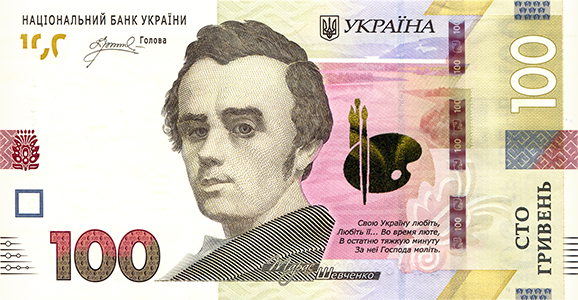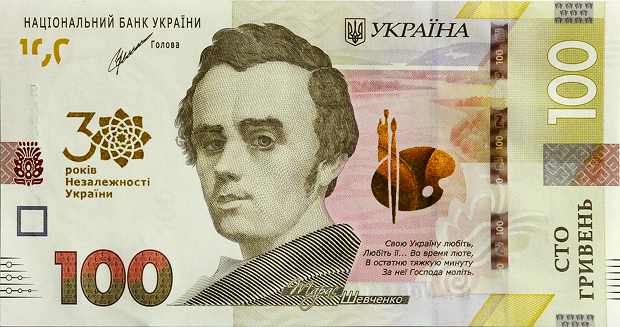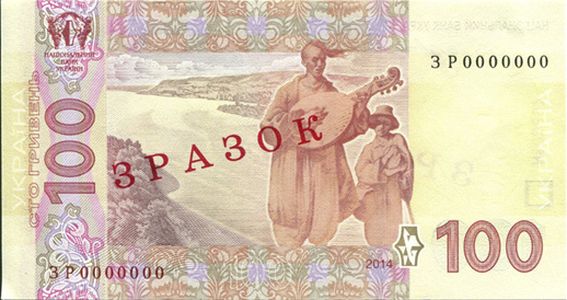On the face side of the note there is a portrait of Taras Shevchenko copied from his self-portrait painted in 1840-1841.
On the reverse side of the note – there is the Chernecha mountain landscape near Chercasy and the figures of a kobzar (Ukrainian bard playing the kobza) and a guide boy.
Taras Shevchenko (1814-1841) is a prominent Ukrainian poet, artist and thinker whose activities culminated the formation of the new Ukrainian literature. The corpus of his poetry Kobzar has been published in more than 100 languages.
The Chernecha mountain landscape near Chercasy and the figures of the kobzar and the guide boy. Taras Shevchenko has been buried in Kaniv on the Chernecha mountain. The figures of the kobzar and the boy are a fragment of the picture by Taras Shevchenko. In his work the painter showed a type of the folk poet singer describing the people life, their joys, sufferings, history.
Security elements
The banknote is printed on the tinted paper of olive color which is the dominating color of the design of the banknote.
Banknote size (75x142) mm.
1. Watermark
A multi-tone portrait, formed by the internal structure of paper, has a fixed position on the banknote and becomes visible when the banknote is held up to the light. Repeats the portrait printed on the face of the note.
1a. Light Watermark Element
Imprint of the numerical indication of the denomination is visible when looking at the banknote against the light.
2. Optically Variable Ink
The numerical indication of the denomination (100) printed with the ink changing its color when viewing at different angles: crimson-violet in perpendicular position and olive-green at a sharp angle.
3. Coded Security Thread
A fully embedded into the paper polymer coded thread with the following transparent direct and inversed images: “100 ГРН”, a trident and the underlined denomination “100”.
4. Latent (Hidden) Images
A numerical indication of the denomination and a word “ГРИВЕНЬ” becomes visible when the banknote is tilted at a sharp angle to the light.
5. Relief Images
Graphic elements on the face of the banknote are printed in special printing when the ink is raised above the paper surface and can be felt by touch: a) the sign for the blind; b) the portrait; d) inscriptions; e) IZARD.
6. See -Through Element
Printed elements on the face and on the back of the banknote which complement each other and form the letter “Y” when the note is held up to the light.
7. "Orloff" Printing
A special type of printing which forms a pattern with the ink of different colors ensuring an abrupt change of one color into another without intermittence and displacement of graphic elements of the pattern (lines, planes).
8. Microtext
Repeated inscriptions which can be read with magnifying glass.
9. Rainbow Printing
Special type of printing ensuring a smooth change of one color into another without intermittence and displacement of graphic elements of the pattern.
10. Serial Number
The serial number is printed in high printing with black inks having magnetic properties.
11. Serial Number
The serial number printed with red inks glowing under the UV light in yellow-red color.
12. Antiscanning Grid
Thin lines placed at different angles which form a moire pattern when copied or scanned.
13. Security Fibers
Chaotically embedded into the paper invisible security fibers glowing in red and green colors under the UV light.
14. Security thread
The 15 mm parts of the thread glow in green-yellow and blue colors (except the edges of the note).
























